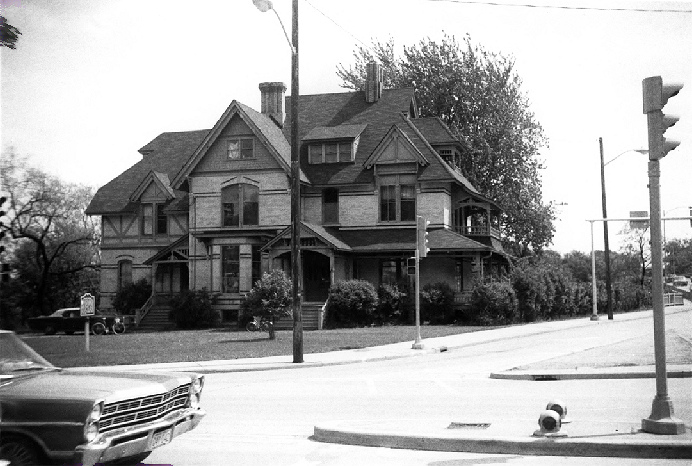Rogers House - Hearth Stone, Appleton Wisconsin

Hearthstone is interesting architecturally as an example of a fine Queen Anne house still in excellent condition. The hand-crafted interior woodwork as well as the fine stained-glass, Minton tiles, and antique furniture make it important for Victorian decorative arts as well. A further significance of Hearth Stone is historical. It was built by Henry J. Rogers an industrialist who had come to Appleton from the East. Rogers wife missed the social life of her native Baltimore, and Rogers is said to have built Hearth Stone to provide her with elegant surroundings which would reconcile her to life in the West. Rogers was a friend of H.E. Jacobs who, in 1882 had taken a job with Thomas Edison, Jacobs convinced Rogers that electricity was the wave of the future, and Rogers devised a scheme to light Hearth Stone, the Vulcan Paper Mill, and the Appleton Paper and Pulp Mill electrically. A generator was purchased from Thomas Edison, and Rogers and three other men founded the Appleton Edison Light Company, Ltd., using the Fox River as their source of power. On September 30, 1882, Hearth Stone was illuminated electrically for the first time.
This first operation of the Appleton plant followed the opening of Thomas Edison's steam operated Pearl Street Station by only twenty-six days; and Edison's plant was not originally used to light any buildings used solely for residential purposes, though it did light some houses associated with industrial purposes. Thus, Hearth Stone was the first residence in America to be lighted from a centrally-located power plant.
The Henry J. Rogers house, also known as Hearthstone, is a brick, Queen Anne house of 1880-82. It has been attributed to William Waters of Oshkosh, one of the foremost architects of the Fox River Valley. The masses of the house are emphasized by the variety of roof-lines, gables, chimneys, dormers and verandas, and by the multiplicity of materials used. The house is done in a light-colored brick which is accentuated by darker brick, by half-timbering, and by shingles. The Rogers house required three years to build. The first year, the foundation of river-bed rock was laid and allowed to cure, and the lumber used in the house was dried in the basement by a fire kept going all winter. The second year the wooden structure and brick bearing walls were built, and the house was substantially finished on the outside. In the third summer all plastering and finishing was done. Besides itss architectural interest, the Rogers house is decorated and furnished with fine Victorian decorative arts including stained-glass Tiffany lampshades, rosewood furniture, art-glass, and oriental rugs. One interesting content of the house is an 1878 silver service by the Racine Silver-Plate Company, the only silversmithing company ever located in Wisconsin. The porches and verandas have elaborately-carved wood spindles and panels which reflect the even higher quality of the wood detailing throughout the interior of the house. All the woodcarving was done by Henry VanStrom, a European craftsman brought to Appleton by the Rogers family especially for work on their house. Woods used include Wisconsin white oak, cherry and bird's-eye maple. The house was electrically lighted soon after its completion and some of the original electrical fixtures remain. The original electrical insulators were in the form of wooden cleats which were nailed to the rafters. Porcelain tubing was run through the joists to carry wiring. The wiring itself was insulated and silk-wrapped. Toggle switches turned the lights on and off. These were hand-made of brass and can still be found in seven places in the house. There were originally nine fireplaces in the Rogers house decorated with Minton tile in scenes from various literary works. For instance, in the foyer the fireplace bore scenes from Shakespeare's plays; there were tiles illustrating the novels of Sir Walter Scott in the library; in the living room, tiles portrayed Longfellow's Evangeline feeding the bluebirds; and in the master bedroom, the fireplace was decorated with scenes from Dickens' Pickwick Papers.
An extensive restoration and renovation program was carried out by the H.D. Mares family. This included cleaning the exterior brick, installing a new roof, replacement of a few porch posts and rails with custom-made duplicates, and a complete re-wiring of the house.





